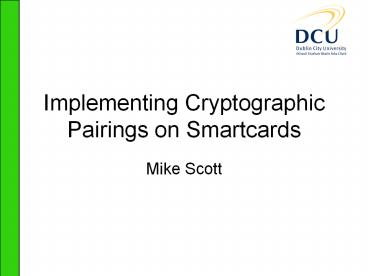Implementing Cryptographic Pairings on Smartcards - PowerPoint PPT Presentation
Title:
Implementing Cryptographic Pairings on Smartcards
Description:
Fast clock speed (up to 36MHz), fast enough to do standard crypto 0.5 second. Triple register ACX|HI|LO. SmartMIPS ... Clock Speed. SmartMIPS Architecture ... – PowerPoint PPT presentation
Number of Views:94
Avg rating:3.0/5.0
Title: Implementing Cryptographic Pairings on Smartcards
1
Implementing Cryptographic Pairings on Smartcards
- Mike Scott
2
Whats a Pairing?
- Denoted e(P,Q), P and Q points on curve over
extension field GF(qk), k is the embedding
degree. - P of order r.
- k smallest integer such that r(qk-1)
- Useful range of k between 2 and 36
- Pairing evaluates as element of order r in GF(qk)
- Pairing algorithm does not need knowledge of r
3
Whats a Pairing?
- MOV condition Dont use these curves!
- Pairing-based Crypto We need these curves!
- Bilinearity e(aP,bQ) e(P,Q)ab e(bP,aQ)
- A Pairing is a flexible crypto primitive with
more structure than most - Famously pairings enable Identity Based
Encryption (IBE)
4
Pairing-friendly Elliptic curves
- Right now we have choice between supersingular
curves, any characteristic, and - Non-supersingular curves of prime characteristic.
- Group size r at least 160 bits.
- Index calculus difficulty at least 1024 bits,
so k.lg(q) at least 1024, where q is the field
size and k is the embedding degree.
5
Pairing-friendly Elliptic curves
- We will use 3 different pairing friendly curves.
In all cases the group size is at least 160 bits. - GF(2m) supersingular curve, m379 and k4
- GF(p) non-supersingular curve, lg(p)512 and k2
(generated using Cocks-Pinch method) - GF(p) non-supersingular curve, lg(p)256 and k4
(generated from a pairing-friendly family see
Freeman-Scott-Teske (to appear))
6
SmartMIPS Architecture
- 32-bit RISC MIPS-based processor.
- No crypto-coprocessor but instruction set
enhancements (Großschadl Savas). - Fast clock speed (up to 36MHz), fast enough to do
standard crypto lt 0.5 second. - Triple register ACXHILO
7
SmartMIPS Architecture
- MADDU instruction multiplies two 32-bit
integers and adds to triple register - MADDP instruction multiplies two 32-bit binary
polynomials and xors to triple register - 5 stage pipeline
- 2k Instruction cache (2-way associative)
- 256k Flash memory
- 16k RAM
8
SmartMIPS Architecture
- Finally a processor with GF(2m) support!
- But MIPS architecture like to loop unroll
- but small instruction cache means that we
cannot unroll to the max ? - CPU Time
- Instructions X CPI
- ----------------------------------
- - Clock Speed
9
SmartMIPS Architecture
- Faster clock speeds implies cache misses are more
costly, which implies greater CPI which implies
greater CPU Time ? - So very important to use tight loops and avoid
cache misses where possible. - Minimizing instruction count is not going to be
optimal!
10
Pairing algorithms
- Chance to show-case state of the art algorithms.
- For GF(2m) curve, the ?T pairing is optimal.
- For GF(p) k2 Cocks-Pinch curve, BKLS algorithm
for the Tate pairing. - For GF(p) k4 FST curve, Ate pairing is best.
- Considered in the context of IBE, the first
parameter to the pairing is fixed, so we will use
precomputation.
11
Pairing algorithms
- All these algorithms need to efficiently handle
extension field arithmetic - Base field GF(q), extension field GF(qk)
12
Implementation
- Uses MIRACL library
- Uses stack only allocation, for everything. All
of the 16k RAM is available for the stack. - Großschadl Savas-like assembly language coding
for the inner loops. - Use the MADDP instruction for assembly language
GF(2m) squaring.
13
Implementation
- In a pairing-based protocol we are also
interested in variable-point multiplication over
the base field GF(q) - (Fixed point multiplication as required in IBE
will be very fast using precomputation) - Also interested in pairing exponentiation.
14
Results Instructions (cache misses)
EGF(2239) ?T k4 E(GF(p) Tate k2 E(GF(p) Ate k4
Pairing 3705344 (10.9) 7753341 (7.3) 8156645 (15.8)
Point Mult. 2589569 (9.6) 7418768 (6.1) 2663217 (17.5)
Field Exp. 151117 (11.4) 1364124 (7.2) 1614016 (15.7)
RSA decrypt 4372772 (3.4)
15
Results Clocks/CPI/Time 9 MHz
EGF(2239) ?T k4 E(GF(p) Tate k2 E(GF(p) Ate k4
Pairing 4311454/ 1.16/0.48 9104450/ 1.17/1.01 10860479/ 1.33/1.21
Point Mult. 3118344/ 1.20/0.35 8529176/ 1.15/0.95 3739596/ 1.40/0.42
Field Exp. 1924596/ 1.24/0.21 1593313/ 1.17/0.18 2122221/ 1.31/0.24
RSA decrypt 4740271/ 1.08/0.53
16
Results Clocks/CPI/Time 36 MHz
EGF(2239) ?T k4 E(GF(p) Tate k2 E(GF(p) Ate k4
Pairing 4891054/ 1.32/0.14 10467010 1.35/0.29 13621597/ 1.67/0.38
Point Mult. 3677188/ 1.42/0.10 9570210/ 1.29/0.27 4847055/ 1.82/0.13
Field Exp. 2326675/ 1.50/0.06 1814285/ 1.33/0.05 2630846/ 1.63/0.07
RSA decrypt 5072415/ 1.16/0.14
17
Results Timings 3GHz Pentium IV
EGF(2239) ?T k4 E(GF(p) Tate k2 E(GF(p) Ate k4
Pairing 3.88 2.97 3.16
Point Mult. 1.82 3.08 1.17
Field Exp. 1.14 0.54 0.62
RSA decrypt 1.92
18
Pairing Delegation
- Idea delegate pairing calculation to the
terminal - Exchange the cost of the pairing for 1 point
multiplications and 3 extension field
exponentiations. - May be beneficial.
19
- Questions ??
- Thank you!
- mike_at_computing.dcu.ie































